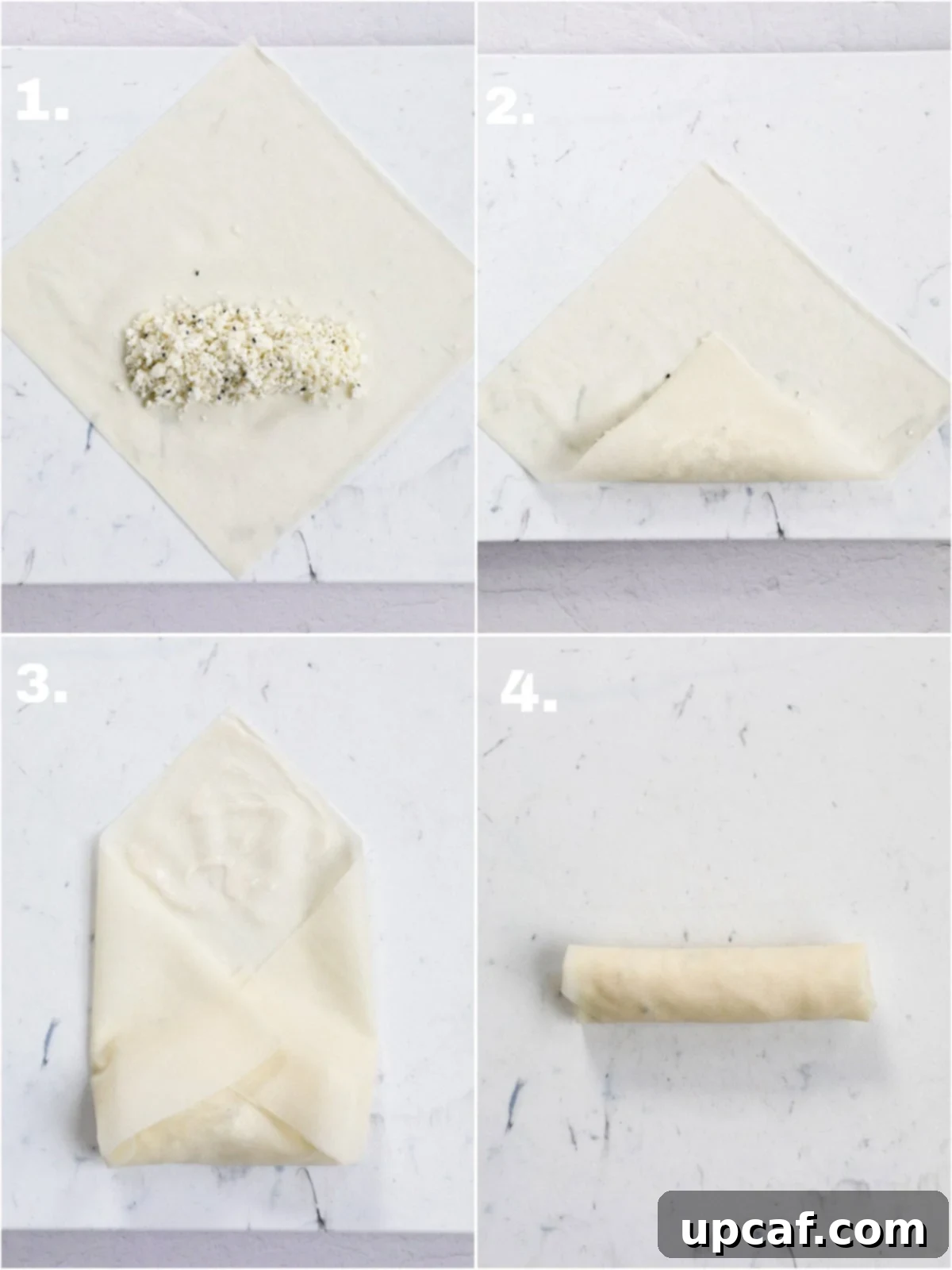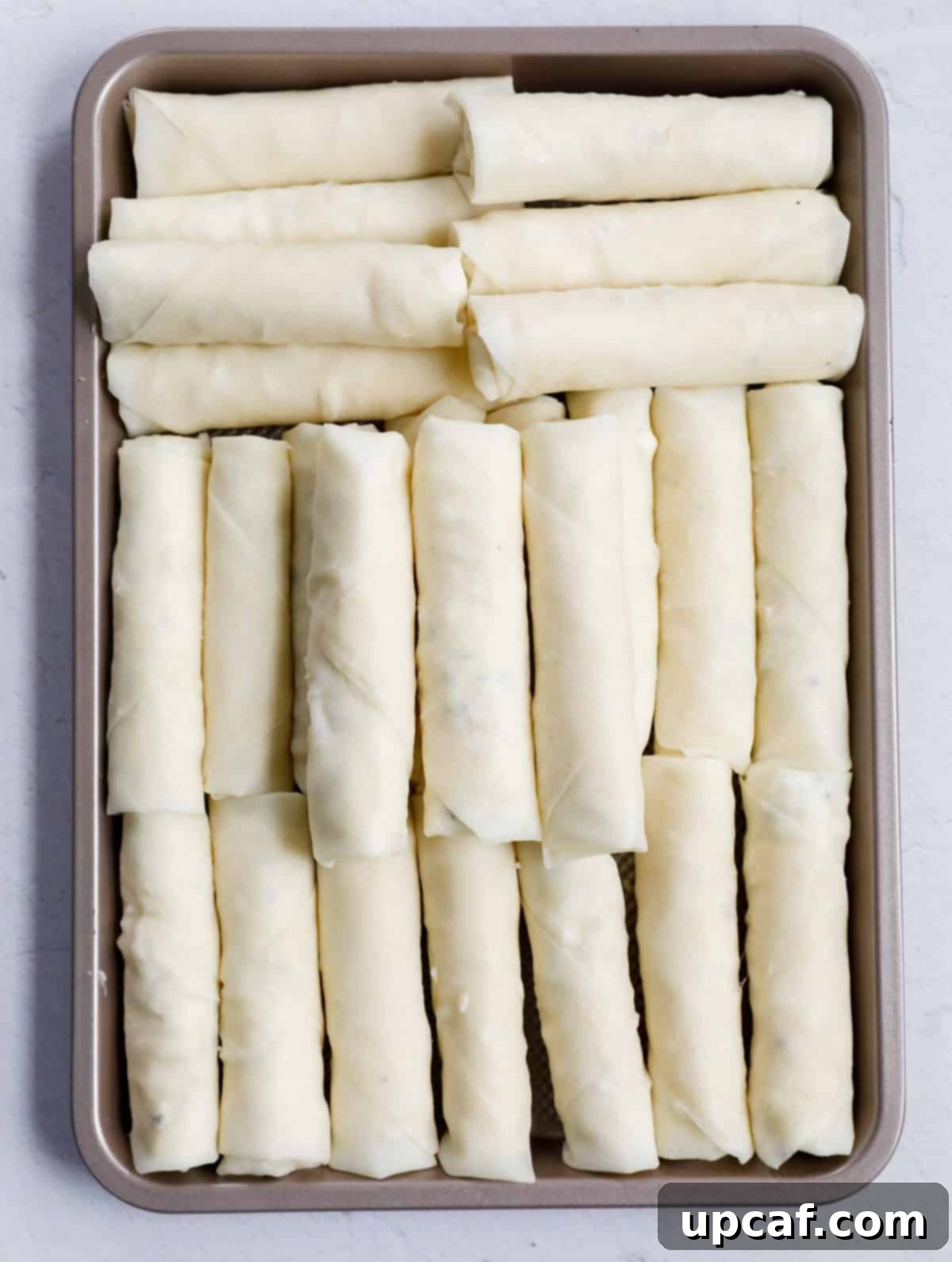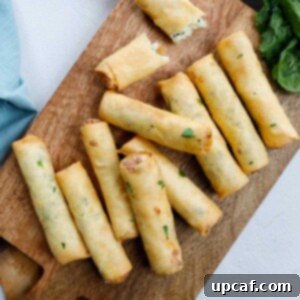Experience the ultimate delight of the Middle East with these incredible Lebanese Cheese Rolls, famously known as “Rakakat Jibneh.” This beloved appetizer features golden, crispy pastry wrappers generously filled with a rich, savory cheese blend, then cooked to perfection until irresistibly crunchy on the outside and wonderfully gooey on the inside. Whether you choose to fry, bake, or air-fry them, these traditional rolls promise a burst of authentic flavor that will transport your taste buds straight to the heart of Lebanese cuisine.

Lebanese cuisine is renowned for its vibrant flavors and diverse array of appetizers, or “mezze.” Rakakat Jibneh stands out as a quintessential starter, celebrated for its comforting blend of textures and tastes. It’s a versatile dish, perfect for casual gatherings, festive celebrations, or simply as a satisfying snack. Its simplicity in preparation belies the complex satisfaction it delivers. These crispy cheese rolls often grace tables alongside other iconic Lebanese dishes. For a truly authentic mezze experience, complement your Lebanese Cheese Rolls with classic Lebanese Hummus and the smoky notes of Baba Ghanouj. The creamy dips and fresh flavors perfectly balance the savory richness of the cheese rolls, creating an unforgettable feast.
Why You’ll Love These Lebanese Cheese Rolls
These Rakakat Jibneh are more than just a snack; they’re an experience. Here’s what makes them an absolute favorite:
- Unforgettable Texture: Revel in the perfect contrast of a delicately crispy, flaky pastry shell enveloping a lusciously gooey, savory cheese filling. Each bite is a textural masterpiece.
- Ideal for Every Occasion: From elegant dinner parties to casual family dinners, these rolls are a crowd-plepleasing appetizer. They also make an excellent party snack, a delightful starter for any meal, or a flavorful side dish for traditional Lebanese feasts.
- Customizable Cooking Methods: Enjoy them exactly how you prefer! They can be easily baked for a lighter option, deep-fried for classic richness, or air-fried for a modern, healthier twist, all while achieving that desirable crispiness.
- Effortless Make-Ahead Option: Streamline your meal prep! These cheese rolls can be assembled in advance and frozen, making them incredibly convenient for spontaneous entertaining or quick weeknight appetizers. Simply pull them out and cook when ready.
- Authentic Flavor Profile: Experience the traditional tastes of the Middle East with a thoughtfully curated blend of cheeses and aromatic herbs, creating a truly authentic and satisfying flavor.
- Simple to Prepare: Despite their gourmet appeal, these Rakakat Jibneh are surprisingly straightforward to make, perfect for both novice and experienced cooks.
Essential Ingredients for Lebanese Cheese Rolls
Crafting perfect Lebanese Cheese Rolls begins with selecting the right ingredients. Each component plays a vital role in achieving that signature flavor and texture:

- Spring Roll Sheets: These thin, delicate wrappers are the key to achieving the incredibly crispy exterior of your cheese rolls. They can typically be found in the freezer section of Asian grocery stores or specialized Middle Eastern markets. Their thinness allows for quick cooking and a light, shatteringly crisp finish.
- Cheese Mixture: The heart of this dish is a harmonious blend of cheeses.
- Akkawi Cheese: A traditional Middle Eastern white brined cheese, known for its mild flavor and slightly salty tang. When melted, it offers a distinct, creamy texture that is central to Rakakat Jibneh.
- Shredded Mozzarella Cheese: Adds a wonderful stretch and gooeyness to the filling, making each bite incredibly satisfying. Its mild flavor perfectly complements the other cheeses.
- Feta Cheese: Introduces a delightful saltiness and a creamy, crumbly texture. Its distinct tangy flavor brightens the entire cheese mixture.
- Dried Mint: This humble herb provides a subtle yet essential refreshing and aromatic note to the cheese filling, lifting the overall flavor profile. It’s a classic addition in many Middle Eastern savory dishes.
- Nigella Seeds: Often mistaken for black sesame seeds, nigella seeds (also known as black cumin or kalonji) impart a unique, slightly peppery, and subtly oniony flavor. They also add a lovely visual appeal to the rolls.
- Oil for Frying: Choose a neutral-flavored oil with a high smoke point, such as canola, vegetable, or sunflower oil, for achieving perfectly golden-brown and crispy rolls.
- Flour Paste or Beaten Egg: A simple mixture of flour and water, or a beaten egg, acts as a natural adhesive to securely seal the edges of your spring rolls, preventing the delicious cheese filling from escaping during cooking.
Ingredient Substitutions and Variations
While the traditional ingredients yield the most authentic flavor, don’t hesitate to experiment with these substitutions based on availability or personal preference:
- Cheese Alternatives: If Akkawi cheese is difficult to find, you can substitute it with other white, mild, semi-soft cheeses like Chicago Cheese, Panela Cheese, Syrian Cheese, Queso Blanco Cheese, or even a blend of halloumi and ricotta for a similar texture and salinity. The goal is a cheese that melts well but still holds some structure.
- Nigella Seed Swaps: For a nutty aroma and a different visual appeal, toasted sesame seeds make an excellent substitute for nigella seeds. They provide a similar crunch and fragrant note.
- Herb Variations: If dried mint is not on hand, fresh finely chopped parsley or dill can offer a fresh, herbaceous counterpoint to the rich cheese. For an earthier, more robust flavor, a pinch of traditional Lebanese Zaa’tar (a blend of thyme, sumac, and sesame seeds) can also be a wonderful addition.
How To Master Lebanese Cheese Rolls (Rakakat Jibneh)
Creating these delightful crispy cheese rolls is a straightforward process. Follow these steps for perfect results every time:




Important Recipe Tips for Perfect Cheese Rolls
Achieving perfectly crispy Lebanese Cheese Rolls is easy with these insider tips:
- Pre-Freeze for Best Results: For an even crispier texture and to help prevent the rolls from absorbing too much oil, consider freezing the assembled rolls for at least 30 minutes, or even longer, before frying or baking. This firms up the cheese and wrapper.
- Roll Them Tightly and Seal Securely: A loose roll is a recipe for disaster. Ensure each roll is wrapped very tightly to prevent it from unraveling. Use enough egg white or flour paste to create a strong seal at the seam; a poorly sealed roll can open up and leak its delicious cheese during cooking.
- Monitor Oil Temperature Closely: Oil temperature is paramount. If the oil is too hot, the wrappers will brown too quickly, leaving the cheese insufficiently melted inside and potentially burnt on the outside. If it’s too cold, the rolls will absorb excessive oil, becoming greasy and soggy. Aim for a consistent 350-375°F (175-190°C) for frying.
- Avoid the Temptation to Overstuff: While it might be tempting to pack in as much cheese as possible, overstuffing can lead to significant leakage during cooking. A tablespoon of filling per roll is usually ample to achieve a satisfying cheese-to-wrapper ratio without risking a messy outcome.
- Serve Immediately for Ultimate Crispiness: Lebanese Cheese Rolls are truly at their best when served hot and fresh, directly after cooking. The crispiness of the wrapper and the meltiness of the cheese are paramount to their appeal. If they sit for too long, they may lose their desired crunch.
- Don’t Overcrowd the Pan: Fry in batches to maintain a consistent oil temperature. Overcrowding can lower the oil temperature rapidly, leading to greasy rolls.
- Use Fresh Spring Roll Wrappers: Ensure your wrappers are fresh and pliable. If they are dry or brittle, they will crack when rolled.

Storing and Reheating Lebanese Cheese Rolls
While Lebanese Cheese Rolls are undoubtedly best enjoyed fresh, here’s how to manage leftovers and prepare them for future indulgence:
How to Store Cooked Cheese Rolls: It’s always recommended to cook only the quantity of rolls you anticipate eating fresh, as their crispiness diminishes over time. However, if you have leftovers, allow them to cool completely before transferring them to an airtight container. Store them in the refrigerator for up to 3 days.
How to Reheat Cooked Cheese Rolls: To revive their delightful crispiness, avoid the microwave. For best results, reheat them in an air fryer at 350°F (175°C) for a few minutes (3-5 minutes), or bake them in a preheated oven at 400°F (200°C) for 5-7 minutes, or until thoroughly warmed through and crispy again. Flipping them halfway through can ensure even reheating.
How to Freeze Uncooked Cheese Rolls: This is an excellent make-ahead strategy! Arrange the uncooked cheese rolls in a single layer on a baking sheet and flash freeze them for about 30-60 minutes until solid. Once firm, transfer them to freezer-safe bags or containers, ensuring they are packed in a flat layer to prevent sticking. They can be stored in the freezer for up to 2 months. When ready to cook, you can fry, bake, or air-fry them directly from frozen, adding a few extra minutes to the cooking time.
Alternative Cooking Methods for Rakakat Jibneh
Beyond traditional deep-frying, these versatile Lebanese Cheese Rolls can be cooked using healthier and equally delicious methods:
Baking: For a lighter option, preheat your oven to 400°F (200°C). Lightly brush the assembled rolls with olive oil or cooking spray, then arrange them on a baking sheet lined with parchment paper. Bake for 15-17 minutes, flipping them halfway through, until they are golden brown and perfectly crispy. Baking provides a wonderful crunch with less oil.
Air Frying: This method delivers exceptional crispiness with minimal oil. Generously spray the uncooked rolls with cooking oil or brush lightly with olive oil. Arrange them in a single layer in your air fryer basket, ensuring not to overcrowd. Air fry at 375°F (190°C) for 10-12 minutes, flipping them halfway, until they are beautifully golden and crunchy. The air fryer circulates hot air, mimicking the crisp texture of frying.
Delightful Filling Variations for Your Cheese Rolls
While the classic cheese blend is undeniably delicious, don’t hesitate to get creative with your fillings. Here are a few ideas to inspire you:
- Lebanese Cheese Rolls with Seasoned Meat: Introduce a hearty element by adding a small amount of finely seasoned ground beef or lamb to your cheese mixture. Cook the meat separately with a pinch of Middle Eastern spices like allspice, cinnamon, and black pepper, then cool and mix with the cheeses.
- Cheese Rolls with Fresh Spinach: For a vibrant, spanakopita-style twist, mix finely chopped and well-drained fresh spinach (or thawed and squeezed frozen spinach) into the cheese filling. Ensure the spinach is completely dry to prevent a soggy filling.
- Spicy Cheese Rolls: Add a kick by incorporating finely diced jalapeños, a pinch of cayenne pepper, or a dash of hot sauce into the cheese blend for those who enjoy a bit of heat.
- Herbaceous Twist: Experiment with different fresh herbs. Beyond mint, finely chopped cilantro, chives, or oregano can add new dimensions of flavor to your cheese rolls.
- Sun-Dried Tomato & Olive: For a Mediterranean flair, add finely chopped sun-dried tomatoes and black olives to the cheese mixture.
Common Questions About Lebanese Cheese Rolls
Absolutely! Rakakat Jibneh are perfect for meal prepping. You can assemble and roll them completely, then store them in the freezer. Simply arrange them in a single layer on a baking sheet to flash freeze, then transfer to a freezer-safe bag or container. When you’re ready to enjoy, cook them directly from frozen, adding a few extra minutes to the cooking time for frying, baking, or air frying.
Lebanese Cheese Rolls are incredibly versatile and pair well with a variety of dishes and accompaniments:
- Dips: Serve them with classic Lebanese dips like creamy hummus, a garlicky toum sauce, or a nutty tahini dip. A simple yogurt-cucumber dip also offers a refreshing contrast.
- Salads: Light, fresh salads like a vibrant Fattoush (cucumber, tomato, radish, and fried pita with sumac dressing) or a zesty Tabbouleh (parsley, tomato, bulgur wheat salad) cut through the richness of the cheese rolls beautifully.
- Main Dishes: They make an excellent appetizer for grilled chicken, succulent kebabs, or crispy falafel platters.
- Breakfast: In Lebanon, cheese rolls are sometimes enjoyed as part of a larger breakfast spread alongside olives, fresh tomatoes, and cucumbers for a truly authentic morning meal.
- Soups: Pair them with a hearty lentil soup or a light vegetable broth for a comforting meal.
The key to maximum crispiness is serving them immediately after cooking. If you need to reheat them, always use an oven or an air fryer to restore their crunchy texture. Microwaving will unfortunately make them soft and chewy, losing their signature crispness. When reheating, ensure they are heated through completely at a moderately high temperature until the wrapper crisps up again.
While spring roll wrappers are traditional for their superior crispiness, you can experiment with phyllo pastry sheets for a flakier, more delicate result. If using phyllo, you’ll need to brush each layer with butter or oil and layer several sheets for strength.
Preventing cheese leakage is crucial. Ensure you don’t overstuff the rolls – about one tablespoon of filling is sufficient. Roll them very tightly, and most importantly, securely seal the edges with a good amount of flour paste or beaten egg. Freezing the rolls for a short period before cooking can also help solidify the cheese, reducing the chance of leakage.

Explore More Lebanese Recipes
If you’ve enjoyed the authentic flavors of these Lebanese Cheese Rolls, delve deeper into the rich culinary traditions of Lebanon with these other fantastic recipes:
- Lebanese Lentil Soup: A comforting and nutritious staple, perfect for any season.
- Grilled Beef Kafta: Flavorful ground beef skewers, seasoned to perfection and grilled until juicy.
- Batata Harra (Lebanese Spicy Potatoes): Irresistibly crispy fried potatoes tossed in a vibrant blend of garlic, cilantro, and chili.
- Lebanese Spinach Pies: Delicious pastries filled with a tangy and savory spinach, onion, and sumac mixture.
- Fattoush Salad: A refreshing bread salad with mixed greens, vegetables, and toasted pita, dressed in a zesty sumac vinaigrette.
- Shish Tawook: Tender and flavorful marinated chicken skewers, a staple on any Lebanese grill.
These authentic Lebanese Cheese Rolls, or Rakakat Jibneh, are truly a culinary gem – a crispy, cheesy delight that’s not only easy to prepare but also utterly impossible to resist. Whether you opt for the rich indulgence of deep-frying, the wholesome charm of baking, or the modern efficiency of air-frying, these rolls are guaranteed to be a hit for any gathering or a delightful treat for yourself. Their simple elegance and explosion of flavor make them a perfect representation of traditional Middle Eastern hospitality.
We encourage you to try this recipe and share your experience. Your feedback, whether a star rating or a comment below, is incredibly valuable. For more delicious recipes and culinary inspiration, be sure to follow Cookin’ With Mima on FACEBOOK, INSTAGRAM, and PINTEREST. Stay connected for all the latest social posts and mouth-watering recipes!

Lebanese Cheese Rolls (رقاقات بالجبنة, Rakakat Jibneh)
Crispy Lebanese Cheese Rolls, also known as “Rakakat Jibneh” are a beloved Middle Eastern appetizer. These golden, crispy rolls are wrapped in thin spring roll wrappers, filled with a flavorful cheese mixture and fried or baked to golden perfection.
Ingredients
- 9 oz. Akkawi cheese, cut into cubes
- 8 oz. feta cheese
- 8 oz. mozzarella cheese, shredded
- 1 tbsp. nigella seeds, or toasted sesame seeds
- 1 tbsp. mint, dry
- 25 spring roll sheets (1 pack)
- Canola or vegetable oil for frying
- Flour paste or egg wash for sealing the ends
Instructions
- Prepare the Filling: In a bowl, mix the shredded Akkawi cheese, mozzarella cheese, feta cheese, dry mint, and nigella seeds until well combined.
- Assemble, Fill and Roll: Lay spring roll sheet on a flat surface. Place a tablespoon of the cheese mixture at the bottom of each strip. Fold the sides inward and roll tightly like a spring roll. Seal the edge with a bit of beaten egg or flour paste mixture.
- Deep Fry: Heat oil to 400°F (200°C). Fry the rolls until golden brown (about 1-2 minutes).
- Serve: Drain on paper towel for a few seconds while they slightly cool down and serve warm.
Notes
- Freeze: If possible, freeze the rolls before cooking for a crispier result.
- Roll Tightly: Loose rolls may open while frying. Seal them well with egg white or flour paste.
- Use the Right Oil Temperature: If the oil is too hot, the rolls will burn; if too cold, they absorb excess oil and the cheese may leak. Use the recommended temperature.
- Avoid Overstuffing: Too much cheese can cause leaks during cooking.
- Serve Immediately: Lebanese cheese rolls are best enjoyed fresh while crispy.
